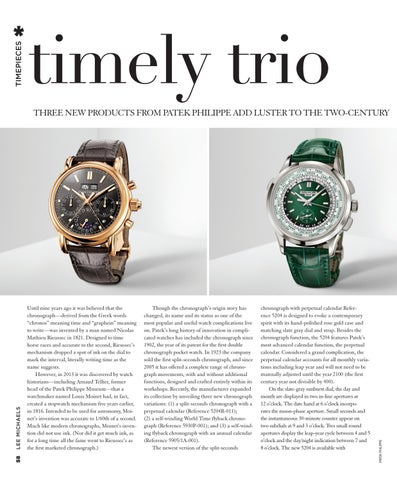TIMEPIECES
timely trio
LEE.ss22.patek.indd 58
Though the chronograph’s origin story has changed, its name and its status as one of the most popular and useful watch complications live on. Patek’s long history of innovation in complicated watches has included the chronograph since 1902, the year of its patent for the first double chronograph pocket watch. In 1923 the company sold the first split-seconds chronograph, and since 2005 it has offered a complete range of chronograph movements, with and without additional functions, designed and crafted entirely within its workshops. Recently, the manufacturer expanded its collection by unveiling three new chronograph variations: (1) a split-seconds chronograph with a perpetual calendar (Reference 5204R-011); (2) a self-winding World Time flyback chronograph (Reference 5930P-001); and (3) a self-winding flyback chronograph with an annual calendar (Reference 5905/1A-001). The newest version of the split-seconds
chronograph with perpetual calendar Reference 5204 is designed to evoke a contemporary spirit with its hand-polished rose gold case and matching slate gray dial and strap. Besides the chronograph function, the 5204 features Patek’s most advanced calendar function, the perpetual calendar. Considered a grand complication, the perpetual calendar accounts for all monthly variations including leap year and will not need to be manually adjusted until the year 2100 (the first century year not divisible by 400). On the slate-gray sunburst dial, the day and month are displayed in two in-line apertures at 12 o’clock. The date hand at 6 o’clock incorporates the moon-phase aperture. Small seconds and the instantaneous 30-minute counter appear on two subdials at 9 and 3 o’clock. Two small round apertures display the leap-year cycle between 4 and 5 o’clock and the day/night indication between 7 and 8 o’clock. The new 5204 is available with
PATEK PHILIPPE
Until nine years ago it was believed that the chronograph—derived from the Greek words “chronos” meaning time and “graphein” meaning to write—was invented by a man named Nicolas Mathieu Rieussec in 1821. Designed to time horse races and accurate to the second, Rieussec’s mechanism dropped a spot of ink on the dial to mark the interval, literally writing time as the name suggests. However, in 2013 it was discovered by watch historians—including Arnaud Tellier, former head of the Patek Philippe Museum—that a watchmaker named Louis Moinet had, in fact, created a stopwatch mechanism five years earlier, in 1816. Intended to be used for astronomy, Moinet’s invention was accurate to 1/60th of a second. Much like modern chronographs, Moinet’s invention did not use ink. (Nor did it get much ink, as for a long time all the fame went to Rieussec’s as the first marketed chronograph.)
58
LEE MICHAELS
THREE NEW PRODUCTS FROM PATEK PHILIPPE ADD LUSTER TO THE TWO-CENTURY
3/15/22 11:46 AM
TRA
